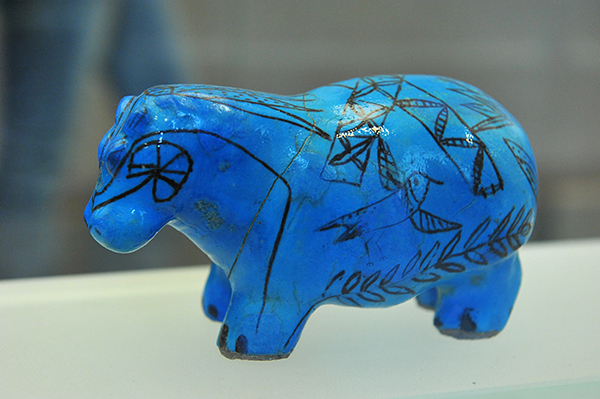
"Blue was first manufactured at Alexandria, and afterwards by Vestorius at Puzzuoli. The method of making it, and the nature of the ingredients, merit our attention. Sand is ground with flowers of sulphur, till the mixture is as fine as flour, to which coarse filings of Cyprian copper are added, so as to make a paste when moistened with water; this is rolled into balls with the hand, and dried. The balls are then put into an earthen vessel, and that is placed in a furnace. Thus the copper and sand heating together by the intensity of the fire, impart to each other their different qualities, and thereby acquire their blue colour."
Vitruvius, On Architecture (XI.9.1)
First used about 2500 BC, copper calcium silicate or "Egyptian blue" was likely the earliest synthetic pigment. Known to the Romans as caeruleus (from the Latin caelum, "sky," cf. "cerulean" or sky blue), its production involved heating a mixture of sand (silica), lime, and copper or copper ore.
One of the most iconic items in the Louvre, this Egyptian blue faience figurine dates to Egypt's classical Middle Kingdom (2033-1710 BC) and is decorated with the aquatic plants (and a bird) of the marshes it inhabited. On the hindquarters of the hippopotamus, one can see a lotus flower in bloom, evoking Egyptian creation myth. On the first morning after the birth of the world from the primordial waters, the sun itself emerged from a lotus flower. Buried in a tomb, the creature prefigured rebirth in the afterlife for its owner.

This detail is from a series of wall paintings discovered in 1820 in the tomb chapel of Nebamun (c.1350 BC) that now are in the British Museum. It is part of a larger scene depicting Nebamun hunting in the marshes along the banks of the Nile, "enjoying himself and seeing beauty" as the hieroglyphic inscription states. A cat catches birds among the papyrus stems, which are painted in Egyptian blue.